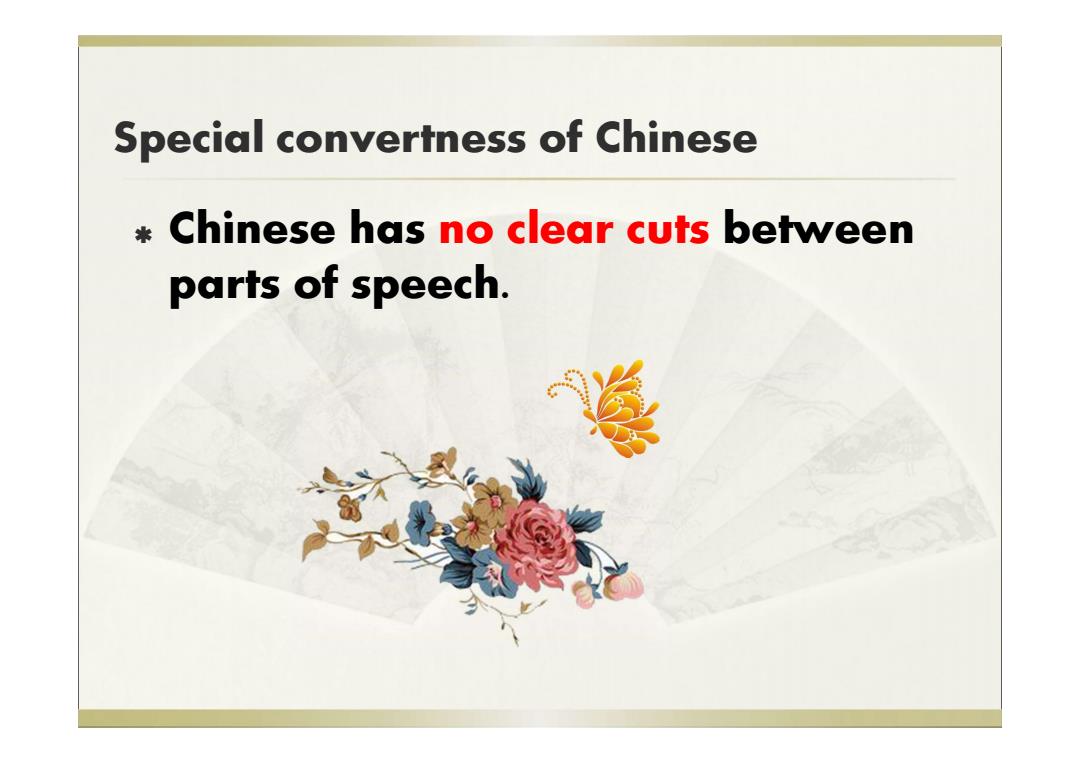
Chapter 5 Overtness and Covertness
Chapter 5 Overtness and Covertness

Comparison *作业写完了! The homework has been finished. *桌上有苹果。 There is an apple/ There are apples *你小心点! on the table. You need to be careful
Comparison 作业写完了! 桌上有苹果。 你小心点! The homework has been finished. There is an apple/ There are apples on the table. You need to be careful

Discussion 1 Compare the Chinese sentences and the English ones in terms of overtness and convertness,and what can you find?
Discussion 1 Compare the Chinese sentences and the English ones in terms of overtness and convertness, and what can you find?

Overtness and Covertness In a general sense,English is a morphological language,while Chinese is semantic language. Thus,roughly,English grammar is explicit, and Chinese Grammar is comparatively implicit. 米 Markers are signals of explicitness. Grammatical markers vs.Semantic markers
Overtness and Covertness In a general sense, English is a morphological language, while Chinese is a semantic language. Thus, roughly, English grammar is explicit, and Chinese Grammar is comparatively implicit. Markers are signals of explicitness. Grammatical markers vs. Semantic markers

Discussion 2 Can you work out some grammatical and semantic markers that distinguish English and Chinese in terms of overtness and covertness?
Discussion 2 Can you work out some grammatical and semantic markers that distinguish English and Chinese in terms of overtness and covertness?

Grammatical markers Tense:-ed,-es,have done/ *Aspect:doing/正在,在 米 Mood:would have done *Voice:be done/被 Gender:--- Number:-es,-s
Tense: -ed, -es, have done/了 Aspect: doing/正在,在 Mood: would have done Voice: be done/被 Gender: --- Number: -es, -s Grammatical markers

Semantic markers Denoting nouns:-ness,-ism,-ace,-ment,-ship, -ancy,-cy,-er,-or,-ty Denoting adjectives:-ful,-able,-eous,-ical, ish,-less,-ish Denoting verbs:-fy,-lize,-en Communication markers:but,although, personally speaking,allegedly,admittedly,I mean/可是,虽然,尽管,我看,我认为,很 遗憾
Denoting nouns: -ness, -ism, -ace, -ment, -ship, -ancy, -cy, -er, -or, -ty Denoting adjectives: -ful, -able, -eous, -ical, - ish, -less, -ish Denoting verbs: -fy, -lize, -en Communication markers: but, although, personally speaking, allegedly, admittedly, I mean/可是, 虽然,尽管,我看,我认为,很 遗憾 Semantic markers

Parts of speech Chinese English 名词 Noun 代词 Pronoun 形容词 Adjective 动词 Verb 实词 副词 Adverb 数词 Numeral 量词 拟声词 Onomatopoeia 介词 Preposition 连词 Conjunction 虚词 叹词 Interjection 助词(语气词) Article
Parts of speech Chinese English 实词 名词 Noun 代词 Pronoun 形容词 Adjective 动词 Verb 副词 Adverb 数词 Numeral 量词 / 拟声词 Onomatopoeia 虚词 介词 Preposition 连词 Conjunction 叹词 Interjection 助词(语气词) / Article

Special convertness of Chinese *板凳宽,扁担长。形容词 词有定类? *长叹一声。 副词 词有定职? *鞭长莫及。 名词 体词(nominals)vs.谓词(predicates) 体词:名词,代词,数词和量词 谓词:动词,形容词和名词
Special convertness of Chinese 板凳宽,扁担长。 长叹一声。 鞭长莫及。 形容词 副词 名词 词有定类? 词有定职? 体词(nominals)vs. 谓词(predicates) 体词:名词,代词,数词和量词 谓词:动词,形容词和名词

Special convertness of Chinese Chinese has no clear cuts between parts of speech
Chinese has no clear cuts between parts of speech. Special convertness of Chinese